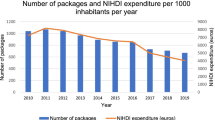Abstract
Background
Antibiotic utilisation varies profoundly among and within countries, and the extent of antibiotic utilisation correlates with the frequency of bacterial resistance, particularly among children. Hence, it is important to assess which factors may influence prescribing. In addition to variations in morbidity, health-care organisation, drug regulatory and supply systems, prescriber's attitudes, parents' behaviour, attitudes and socio-economic positions seem important. We compared socio-economic position (educational level of adults) and antibiotic utilisation in children in the municipalities within a Danish and a Swedish county which are geographically close, have similar social and economic development, and similar drug regulatory and supply systems.
Methods
Data on antibiotic utilisation (1998), expressed in defined daily doses per 1000 inhabitants per day (DDD/TID), were obtained from the Copenhagen County Health Insurance register and from the National Corporation of Swedish Pharmacies. Data on municipal educational levels were obtained from Statistics Denmark and Statistics Sweden.
Results
The utilisation of antibiotics in 0- to 6-year-old children was higher in the Swedish than in the Danish county but varied between the municipalities within both the Swedish (9.6–17.7 DDD/TID) and the Danish (8.0–12.9 DDD/TID) counties. Most notably, utilisation rates correlated negatively with the education levels in the Danish (r=−0.539, P=0.021) but positively in the Swedish (r=+0.390, P=0.025) municipalities.
Conclusion
The observed variations in antibiotic prescribing may reflect different parental and/or prescriber attitudes towards use of antibiotics and they emphasise that antibiotic prescribing is influenced by factors other than the prevalence of bacterial infections. Relationships between socio-economic position (educational level) and drug utilisation should not be generalised from one area to another.


Similar content being viewed by others
References
Bergman U, Elmes P, Halse M, et al (1975) The measurements of drug comparison. Drugs for diabetes in Northern Ireland, Norway and Sweden. Eur J Clin Pharmacol 8:83–89
Merlo J, Ranstam J, L Råstam L, Wessling A, Melander A (1994) Age standardisation of drug utilisation: comparisons of different methods using cardiovascular drug data from Sweden and Spain. Eur J Clin Pharmacol 46:393–398
Merlo J, Råstam L, Ranstam J, Wessling A, Melander A (1996) Out-patient antihypertensive drug utilisation and stroke mortality An ecological study. Eur J Publ Health 6:113–117
Mölstad S, Hovelius B, Kroon L, Melander A (1990) Prescription of antibiotics in out-patients in hospital clinics, community health centres and private practice. Eur J Clin Pharmacol 39:9–12
Ekedahl A, Lidbeck J, Lithman T, Noreen D, Melander A (1993) Benzodiazepine prescribing patterns in a high-prescribing Scandinavian community. Eur J Clin Pharmacol 44:141–146
Henricson K, Carlsten A, Ranstam J, Rametsteiner G, Stenberg P, Wessling A, Melander A (1999) Utilisation of codeine and propoxyphene: geographic and demographic variations in prescribing, prescriber and recipient categories. Eur J Clin Pharmacol 55:605–611
Henricson K, Stenberg P, Rametsteiner G, Ranstam J, Hanson BS, Melander A (1998) Socioeconomic factors, morbidity and drug utilization: an ecological study. Pharmacoepidemiol Drug Safety 7:261–267
Cars O, Mölstad S, Melander A (2001) Variation in antibiotic use in the European Union. Lancet 357:1851–1852
Mölstad S, Lundborg CS, Karlsson AK, Cars O (2002) Antibiotic prescription rates vary markedly between 13 European countries. Scand J Inf Dis 34:366–371
Melander E, Ekdahl K, Jönsson G, Mölstad S (2000) Frequency of penicillin-resistant pneumococci in children is correlated to community utilization of antibiotics. Ped Infect Dis J 12:1172–1177
Henricson K, Melander E, Mölstad S, Ranstam J, Hanson BS, Rametsteiner G, Stenberg P, Melander A (1998) Intraurban variation of antibiotics utilisation in children: influence of socioeconomic factors. Eur J Clin Pharmacol 54:653–657
Bronzwaer S, Cars O, Bucholz U, Mölstad S, Goettsch W, Veldhuijzen I, Kool J, Sprenger M, Degener J (2002) A European study on the relationship between antimicrobial use and antimicrobial resistance in Europe. Emerg Inf Dis 8:278–282
Hjern A, Haglund B, Rosén M (2001) Socioeconomic differences in use of medical care and antibiotics among school-children in Sweden. Eur J Publ Health 11:280–283
Edwards DJ, Richman PB, Bradley K, Eskin B, Mandell M (2002) Parental use and misuse of antibiotics: are there differences in urban vs. suburban settings? Acad Emerg Med 9:22–26
Lynch JW, Kaplan GA (2000) Socioeconomic position. In: Berkman LF, Kawachi I (eds) Social epidemiology. Oxford University Press, New York, pp 13–35
Geronimus, AT, Bound J (1998) On the use of census-based aggregate variables to proxy for socioeconomic group: evidence from national samples. Am J Epidemiol 148:475–486
Merlo J, Wessling A, Melander A (1996) Comparison of dose standard units for drug utilisation studies. Eur J Clin Pharmacol 50:27–30
Mohammed MA, Cheng KK, Rouse A, Marshall T (2001) Bristol, Shipman and clinical governance: Shewhart's forgotten lessons. Lancet 357:463–467
Merlo J, Ostergren PO, Hagberg O, Lindstrom M, Lindgren A, Melander A et al (2001) Diastolic blood pressure and area of residence: multilevel versus ecological analysis of social inequity. J Epidemiol Community Health 55:791–798
Morgenstern H (1998) Ecological studies. In: Rothman KJ, Greenland S (eds) Modern epidemiology. Lippincott-Raven, Philadelphia, pp 459–480
Pennie RA (1998) Prospective study of antibiotic prescribing for children. Can Fam Physician 44:1850–1856
Lundborg CS, Olsson E, Mölstad S and the Swedish Group on Antibiotic Use (2002) Antibiotic prescribing in outpatients a one-week diagnosis-prescribing study in five counties in Sweden. Scand J Inf Dis 34:442–448
Forsell G, Håkansson A, Månsson N-O (2001) Risk factors for respiratory tract infections in children aged 2–5 years. Scand J Prim Health Care 19:122–125
Danish Yearbook of Statistics 2001. Social circumstances, health and judicial system (In Danish)
Municipality personnel in Sweden. Swedish Association of Municipalities (1998)
Sweden's statistical databases. Statistics Sweden 2002
StatBank Denmark. Statistics Denmark 2002
Workshop, Swedish Medical Products Agency (1995) Treatment of acute respiratory tract infections in primary health service. vol. 4
Institute for Rational Pharmacotherapy, Danish Medical Product Agency (2001) Rational pharmacotherapy no.7
Danish Medical Association (2001) Drug list of the Danish Medical Association 2001/2002. Laegeforeningens Forlag, Copenhagen, p 840
Melander E, Björgell E, Björgell A, Ovhed I, Mölstad S (1999) Medical audit changes antibiotic prescribing in respiratory tract infections. Scand J Prim Health Care 17:181–184
Mölstad S, Cars O (1999) Major decrease in antibiotics utilisation following a national programme on antibiotics use. Scand J Infect Dis 31:191–195
Friis H, Bro F, Mabeck CE, Vejlsgaard R (1991) Changes in prescription of antibiotics in general practice in relation to different strategies for drug information. Dan Med Bull 38:380–382
Odenholt I, Bylander-Groth A, Frimodt-Moller N, Rokstad KS, Mölstad S (2002) Differences in antibiotic prescribing patterns between general practitioners in Scandinavia: a questionnaire study. Scand J Infect Dis 34:602–609
Acknowledgement
This work was supported by a grant from the Knut and Alice Wallenberg's Foundation and by the NEPI Foundation.
Author information
Authors and Affiliations
Corresponding author
Rights and permissions
About this article
Cite this article
Melander, E., Nissen, A., Henricson, K. et al. Utilisation of antibiotics in young children: opposite relationships to adult educational levels in Danish and Swedish counties. Eur J Clin Pharmacol 59, 331–335 (2003). https://doi.org/10.1007/s00228-003-0624-0
Received:
Accepted:
Published:
Issue Date:
DOI: https://doi.org/10.1007/s00228-003-0624-0




